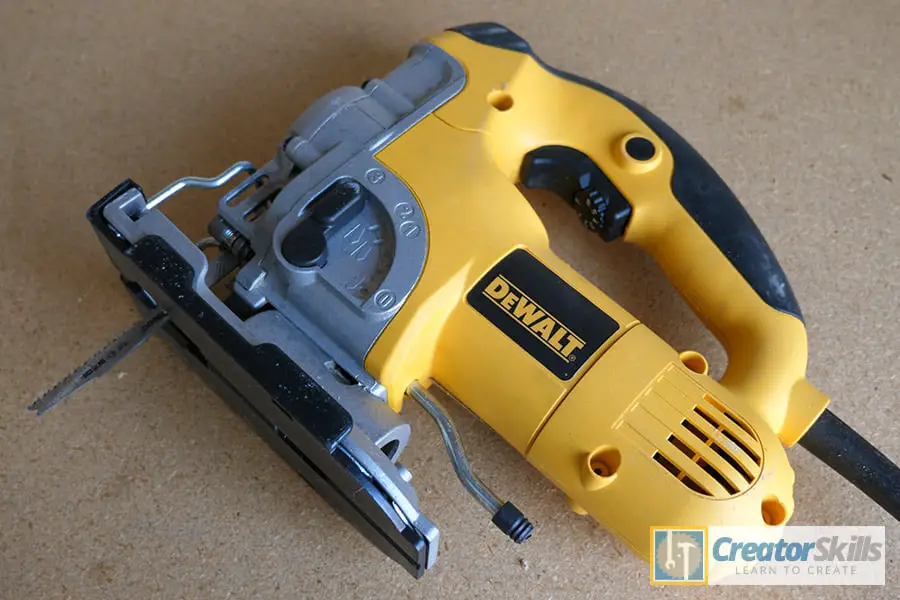
People often wonder about a jigsaw and when to use them. I’ll explain why you need a jigsaw and what you need them for .
So when do you need a jigsaw? You need a jigsaw when you need to cut tighter and more detailed interior curves that other saws can’t cut as effectively. A jigsaw is very portable and can be used to cut many different materials. If you’re a beginner, you need a jigsaw when you don’t have any other tools.
Many people are curious about the strengths and weaknesses of a jigsaw, and when to use them. I’ll go over some scenarios below that demonstrate when having a jigsaw makes life a lot easier.
You Need a Jigsaw When Cutting Tight Curves
Tons of saws cut curves, but sometimes those other saws have drawbacks to using them. A jigsaw is a tool that is really good at cutting curves with a lot of control. This includes curves that are too tight for a circular saw to maneuver, and interior cuts that a bandsaw can’t physically get to.
Imagine having a 1 foot by 1 foot square piece of plywood. What if you wanted to cut out a circle from the inside of the square that had a diameter of 8 inches?
The circular saw couldn’t make the turn because it’s blade is almost 8 inches straight by itself, and the blade doesn’t bend.
The bandsaw could cut the outside of the circle without a problem, turning the square plywood into a circle. Using a bandsaw won’t allow you to cut the circle out of the square because it’s would have to cut through the square to get to the inside of the circle.
You Need a Jigsaw When You Don’t Have Access to Other Tools
You could use a jigsaw in a million ways in your daily life, let alone when you’re building something. If I was stuck on a desert island (And let’s say it magically had electricity and tons of building materials) and could only bring one saw, a jigsaw would probably be the saw I choose.
A jigsaw can make cross cuts, rip plywood, cut angles, and most importantly cut curves in just about every material you can imagine.
Let’s go back to the circle example, but this time we do want to turn the square into the circle. You’d need a jigsaw to create the circle if you didn’t have a bandsaw. If you did have a bandsaw, you probably wouldn’t be reading information on when you need a jigsaw.
You could technically use a reciprocating saw (AKA Sawzall) to cut out the circle, but I also doubt that you’d ask the question if you had one of those as well. This brings me to my next point.
You Need a Jigsaw When You Care About What Your Cut Looks Like
Depending on your project, you might care about what the end product looks like. If you do, then a jigsaw is a great tool to have when cutting curves.
A reciprocating saw is like a jigsaw on steroids. This makes controlling it much harder than controlling a jigsaw. Sometimes a reciprocating saw will end up “getting away from you” and not give you nearly as accurate of cut as you intended, which a jigsaw would easily give you.
A jigsaw with the proper blade will leave you with relatively smooth and cuts. A reciprocating saw, on the other hand, ends up leaving your material a little more rough. This is why they are used mostly in demolition environments.
A circular saw could be used to cut longer and less curved cuts, but a jigsaw will probably come out on top when it comes to looks. A circular saw also requires a little bit more strength and force to make tighter cuts. Extra force with any type of saw results in a much rougher looking cut.. You need a jigsaw when you don’t want to force a saw through your workpiece because you want it to look nice.
You can also end up getting a nice looking curved cut with a bandsaw with the proper blade. But if your cut is on the interior, only a jigsaw with do!
What Can a Jigsaw Cut
A jigsaw is a great tool because it can be used in many different ways. Not only can it cut wood, it can cut other materials like metal, fiberglass, masonry, drywall, dense foam, plastic, and even ceramic material.
When cutting different materials, make sure to have the proper type of blade in your jigsaw. Sometimes you’ll be attempting to cut something and it’ll either not be working, or working, but at an extremely slow pace. This is miserable, but it can be fixed by something as simple as taking 2 minutes to change to the proper jigsaw blade. Having the right jigsaw blade for the job makes the biggest difference in the end result and how long it takes to get there.
Having this type of flexibility to cut through all those different types of materials with one single tool is why most people end up buying a jigsaw as one of their first tools in the first place.
Other Good to Have Tools for Beginners
Having multiple tools is a good because, obviously, you can do more things with more tools. If you don’t have many tools, here is a helpful list of tools to begin with and examples on when and what they’re used for.
- Circular Saw – This is a great tool to have that compliments a jigsaw. A circular saw is great for cutting straight lines in a short amount of time. It can shred both dimensional lumber (2×4’s, 2×6’s, 2×8’s, 2×10’s, & 2×12’s. For thicker dimensional lumber, I’d use a miter saw or bandsaw) and sheet material (Plywood, particle board, insulation/foam). I’d definitely want to have a jigsaw first, though.
- Cordless Impact Driver – Most people have normal screwdrivers laying around their house and maybe a power drill. An impact driver is the ultimate screwdriver. A normal power drill can drill holes and drive small fasteners. An impact driver shines when you need to focus on driving in long fasteners. This would include long screws and bolts for more heavy duty projects involving brick and concrete. It makes life much easier by pounding things into place like a hammer along with spinning like a traditional screwdriver.
- Hammer – A hammer is great because you can do a ton of things with it. Most people just think of driving in nails when they think of a hammer. I like to think that a hammer is a tool that moves things that don’t want to be moved! A hammer can be used to demolish things (Like breaking up drywall), bend things (Like metal that doesn’t seem to quite fit), and even loosen things (Sometimes rusty bolts need a good whack to come loose). They’re also inexpensive and portable.
- Tape Measure – This is an absolute must have for anyone who likes building things. You need to be able to measure how big things are all the time when your working on pretty much any project. Tape measures are small (Which is both good and bad), cheap, and portable. I have a few tape measures scattered around my house and workshop because they are really handy to have around. I always lose them too because of their small size too, which is a bummer.
Conclusion for When Do You Need a Jigsaw
People need to have a jigsaw because of the many ways it can be used. A jigsaw really shines on cutting curves and getting into tight spots that other tools can’t get into. It’s ability to cut many materials, in many ways, at such a low cost is absolutely amazing.
As always, if you have any questions or comments, reach me in the section below!
